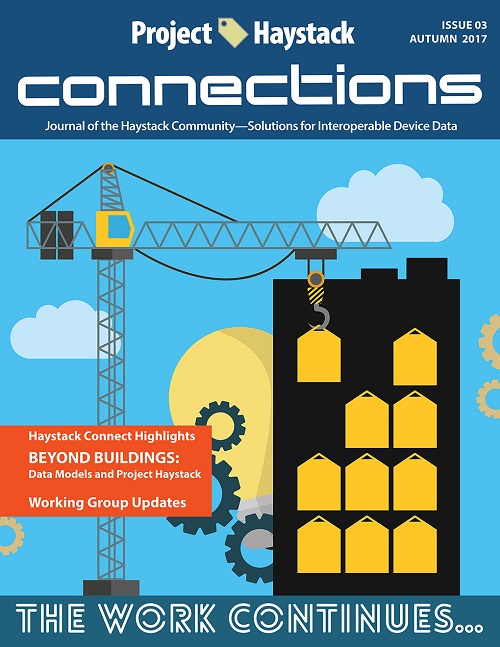Look for New Edition of Haystack Connections October 1st
 Therese Sullivan,
Therese Sullivan,Founder, BuildingContext Ltd
Editor, Haystack Connections
Contributing Editor
|
October 2017 |
[an error occurred while processing this directive] |
| Haystack Connections Third Edition Look for New Edition of Haystack Connections October 1st |
 Therese Sullivan, Therese Sullivan,Founder, BuildingContext Ltd Editor, Haystack Connections Contributing Editor |

| Articles |
| Interviews |
| Releases |
| New Products |
| Reviews |
| [an error occurred while processing this directive] |
| Editorial |
| Events |
| Sponsors |
| Site Search |
| Newsletters |
| [an error occurred while processing this directive] |
| Archives |
| Past Issues |
| Home |
| Editors |
| eDucation |
| [an error occurred while processing this directive] |
| Training |
| Links |
| Software |
| Subscribe |
| [an error occurred while processing this directive] |
The third issue of Haystack Connections, the magazine
for the Project-Haystack community is on https://project-haystack.org/
under the Downloads tab, or we have a direct link to magazine as a pdf here. This issue came together naturally around the theme of “The Work
Continues,” i.e. how the community goes about developing a semantics
methodology for device data that can be used to tag not only building
data but virtually any IoT or smart-and-connected device application
today. The Haystack community has collected some of the best data
engineers with building-performance experience in the world into its
organization.
Most
of our community collaboration happens online. But, the excitement of
bringing these minds together in one place was palpable last Spring at Haystack Connect 2017. A lot of
work was accomplished in the relaxed setting of the Saddlebrook Resort,
so there is a big Haystack Connect
Highlights
section in this issue. There are articles on some of the many
presentations given over those few days. I report on the keynotes by
the data scientists Rita Wouhaybi of Intel and Milan Milenkovak of
IoTSense. They both offered valuable IT-industry perspectives and key
takeaways about the role our community is poised to play in bringing
data interoperability to the IoT-world at large.
I sampled those break-out sessions that were most specifically educational when it comes to using Haystack tagging. The Haystack Connect conference covered the subject of data interoperability with much wider scope, and there is so much more content at www.haystackconnect.org. I hope that readers will be encouraged to explore further there, once they’ve absorbed the overview provided in the magazine.
Keeping
with the theme of the Haystack community at work, this Autumn 2017
edition highlights the fact that eight new semantic tagging working
groups were launched this summer. There is an article from
Matthew Giannini, who has led the effort to make the organization’s
website more working-group-friendly. I was happy to cover the
thought-leadership of some of the champions that have stepped up to
lead working groups, such as Karine Lavigne of Hydro-Quebec Research
Institute. She is keen to have the group consider some new types of
tags that would improve the ease with which Haystack users can express
how energy, air, water, electricity, and other flows move between
points or objects.
Again, I hope the sample coverage in the magazine piques your interest enough to explore further on the Project Haystack website—and perhaps to even join a group if you are a member. At the website, you’ll find there are working groups that focus on the specific semantics and tagging challenges presented by the data center and lab environments, as well as by refrigeration and chiller plant specifics. When it comes to expressing spatial characteristics, like zones in a space, there is great overlap and integration challenges with matching Haystack hierarchy with BIM modeling standards. A BIM expert within the community, Chris Renter of Stuart-Olsen is leading the BIM working group. He is championing Haystack in other ways too, for example, he spoke about the methodology and markup language at CanBIM Toronto 2017 last month.
[an error occurred while processing this directive]A
new feature that I’ve launched with this edition is the Member Profile.
Matt Horton of Tampa Bay-area-based SensorFact Services, a cloud-based
data acquisition and storage service for sensor data, was the member
that I interviewed and wrote about this time. You can also read
editorials from other Haystack members in the Voices
section of the magazine. In this issue there are posts from Anno Scholten
of Connexx Energy, Alper Uzmezler of BASSG and Anka Labs, as well as B.
Scott Muench of J2 Innovations. In the Resources
section, we are excited to announce the availability of the Haystack
Guide specification in Chinese. This new document was the result of
work by Project-Haystack.org members in China and shows the growing
international support for Project Haystack as the markup language for
device data. The Chinese language Guide Specification can be found on
the Downloads page here.
I
realize that I included this quote from Rob Murchinson of Intelligent
Buildings, heard at Haystack Connect
2017,
in my article last month for AutomatedBuildings.com, but it is worth
repeating: Rob said “100% of us believe in the value of data, and that
is why we are here. But, in the broader market—across the 87 billion
square feet of real estate just in the US—we’re a small minority.”
Well,
as the anthropologist Margaret Mead famously said “Never doubt that a
small group of thoughtful, committed, citizens can change the world.
Indeed, it is the only thing that ever has.” That is certainly true of
the Project Haystack community. Haystack
Connections is another way that we’re striving to demonstrate
that thoughtfulness and commitment.
[an error occurred while processing this directive]
[Click Banner To Learn More]
[Home Page] [The Automator] [About] [Subscribe ] [Contact Us]